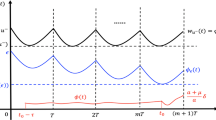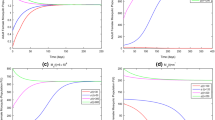Abstract
Based on the idea that only sexually active sterile mosquitoes are included in the modeling process, we study the dynamics of the interactive wild and sterile mosquito model with time delay, which consists of three sub-equations. Due to the fact that the maturation period of sterile mosquitoes bred in the lab or mosquito factories is almost the same time period of wild adult mosquitoes matured from larvae, we particularly assume that the waiting period for two consecutive releases of sterile mosquitoes equals the maturation period of wild mosquitoes, as a new practical sterile mosquito release strategy. We first ingeniously solve the delay model with the initial functions that are solutions of the corresponding equation without delay and we call them “good” solutions. Using these “good” solutions, we then surprisedly obtain sufficient and necessary conditions for the trivial solution and a unique periodic solution of the delay model to be globally asymptotically stable, respectively. We provide a numerical example to demonstrate the model dynamics and brief discussions of our findings as well.


Similar content being viewed by others
References
Ai S, Li J, Yu J, Zheng B (2021) Stage-structured models for interactive wild and periodically and impulsively released sterile mosquitoes. Dis Cont Dyn Syst Series B. https://doi.org/10.3934/dcdsb.2021172
Barclay HJ (1982) Pest population stability under sterile releases. Res Popul Ecol 24:405–416
Barclay HJ (2005) Mathematical models for the use of sterile insects, In: V.A. Dyck, J. Hendrichs, and A.S. Robinson (eds) Sterile Insect Technique. Principles and practice in area-wide integrated pest management, Springer, Heidelberg, pp 147–174
Barclay HJ, Mackuer M (1980) The sterile insect release method for pest control: a density dependent model. Environ Entomol 9:810–817
Briggs G (2012) The endosymbiotic bacterium Wolbachia induces resistance to dengue virus in Aedes aegypti. PLoS Pathog 6:e1000833
Cai L, Ai S, Fan G (2018) Dynamics of delayed mosquitoes populations models with two different strategies of releasing sterile mosquitoes. Math Biosci Eng 15:1181–1202
Cai L, Ai S, Li J (2014) Dynamics of mosquitoes populations with different strategies for releasing sterile mosquitoes. SIAM J Appl Math 74:1786–1809
CDC, Life cycle: the mosquito, 2019, https://www.cdc.gov/dengue/resources/factsheets/mosquitolifecyclefinal.pdf
Hu L, Huang M, Tang M, Yu J, Zheng B (2015) Wolbachia spread dynamics in stochastic environments. Theor Popul Biol 106:32–44
Huang M, Hu L, Zheng B (2019) Comparing the efficiency of Wolbachia driven Aedes mosquito suppression strategies. J Appl Anal Comput 9:1–20
Huang M, Hu L, Yu J, Zheng B (2016) Qualitative analysis for a Wolbachia infection model with diffusion. Sci China Math 59:1249–1266
Huang M, Luo J, Hu L, Zheng B, Yu J (2018) Assessing the efficiency of Wolbachia driven Aedes mosquito suppression by delay differential equations. J Theor Biol 440:1–11
Huang M, Song X, Li J (2017) Modeling and analysis of impulsive releases of sterile mosquitoes. J Biol Dyn 11:147–171
Huang M, Tang M, Yu J (2015) Wolbachia infection dynamics by reaction-diffusion equations. Sci China Math 58:77–96
Huang M, Tang M, Yu J, Zheng B (2019) The impact of mating competitiveness and incomplete cytoplasmic incompatibility on Wolbachia-driven mosquito population suppression. Math Bios Eng 16:4741–4757
Huang M, Tang M, Yu J, Zheng B (2020) A stage structured model of delay differential equations for Aedes mosquito population suppression. Discrete Cont Dyn Syst 40:3467–3484
Hutchings JA (2005) Life history consequences of overexploitation to population recovery in Northwest Atlantic cod (Gadus morhua). Can J Aquat Sci 62:824–832
Laurian C, Ouellet JP, Courtois R, Breton L, St-onge S (2000) Effects of intensive harvesting on moose reproduction. J Appl Ecol 37:515–531
Li J (2004) Simple mathematical models for interacting wild and transgenic mosquito populations. Mat Biosci 189:39–59
Li J (2008) Differential equations models for interacting wild and transgenic mosquito populations. J Biol Dyn 2:241–258
Li J (2010) Modeling of mosquitoes with dominant or recessive transgenes and Allee effects. Math Biosci Eng 7:101–123
Li J, Ai S (2020) Impulsive releases of sterile mosquitoes and interactive dynamics with time delay. J Biol Dyn 14:313–331
Li J, Cai L, Li Y (2017) Stage-structured wild and sterile mosquito population models and their dynamics. J Biol Dyn 11:79–101
Stearns SC (1989) Trade-offs in life-history evolution. Funct Ecol 3:259–268
Walker T, Johnson PH, Moreika LA et al (2011) The wmel Wolbachia strain blocks dengue and invades caged Aedes aegypti populations. Nature 476:450–453
Wikipedia, Sterile Insect Technique, 2021, https://en.wikipedia.org/wiki/Sterile_insect_technique
Xi Z, Khoo CC, Dobson SI (2005) Wolbachia establishment and invasion in an Aedes aegypti laboratory population. Science 310:326–328
Yu J (2018) Modelling mosquito population suppression based on delay differential equations. SIAM J Appl Math 78:3168–3187
Yu J (2020) Existence and stability of a unique and exact two periodic orbits for an interactive wild and sterile mosquito model. J Differ Equ 269:10395–10415
Yu J, Li J (2019) Dynamics of interactive wild and sterile mosquitoes with time delay. J Biol Dyn 13:606–620
Yu J, Li J (2020) Global asymptotic stability in an interactive wild and sterile mosquito model. J Differ Equ 269:6193–6215
Yu J, Zheng B (2019) Modeling Wolbachia infection in mosquito population via discrete dynamical models. J Differ Equ Appl 25:1549–1567
Zhang X, Tang S, Cheke RA (2015) Models to assess how best to replace dengue virus vectors with Wolbachia-infected mosquito populations. Math Biosci 269:164–177
Zheng B, Guo W, Hu L, Huang M, Yu J (2018) Complex Wolbachia infection dynamics in mosquitoes with imperfect maturnal transmission. Math Biosci Eng 15:523–541
Zheng B, Li J, Yu J (2021a) One discrete dynamical model on Wolbachia infection frequency in mosquito populations. Sci China Math. https://doi.org/10.1007/s11425-021-1891-7
Zheng B, Yu J, Li J (2021b) Modeling and analysis of the implementation of the Wolbachia incompatible and sterile insect technique for mosquito population suppression. SIAM J Appl Math 81:718–740
Zheng B, Tang M, Yu J (2014) Modeling Wolbachia spread in mosquitoes through delay differential equation. SIAM J Appl Math 74:743–770
Zheng B, Tang M, Yu J, Qiu J (2018) Wolbachia spreading dynamics in mosquitoes with imperfect maternal transmission. J Math Biol 76:235–263
Zheng B, Yu J (2022) Existence and uniqueness of periodic orbits in a discrete model on Wolbachia infection frequency. Adv Nonlinear Anal 11:212–224
Zheng X, Zhang D, Li Y, Yang C, Wu Y, Liang X et al (2019) Incompatible and sterile insect techniques combined eliminate mosquitoes. Nature 572:56–61
Author information
Authors and Affiliations
Corresponding author
Additional information
Publisher's Note
Springer Nature remains neutral with regard to jurisdictional claims in published maps and institutional affiliations.
This work is supported by National Natural Science Foundation of China (12071095, 11631005) and the Program for Changjiang Scholars and Innovative Research Team in University (No: IRT16R16).
Appendices
Appendixes
Proof of Lemma 3.3
Proof
(1). We prove inequality (3.7) by contradiction. For convenience, we omit \(t_0\) in \(w_u(t;t_0)\). Assume that (3.7) is not true. Since \(w_u(t_0)=\phi _u(t_0) > \phi _u(t_0-\tau ) \) from Lemma 3.2, there is \(\bar{t}>t_0\) such that
where \(\delta >0\) is sufficiently small. Then we can choose \(t_1\in (\bar{t},\bar{t}+\delta )\) such that \(w'_u(t_1) < w'_u(t_1-\tau )\).
Now we show \(\bar{t}\ge 2T\). In fact, if \(\bar{t}\in (T,T+\bar{T})\), then we have, from (2.6) and (3.2),
and
which yields \(w_u(t_1) > w_u(t_1-\tau )\), a contradiction to (A.1).
If \(\bar{t}\in [T+\bar{T},2T)\), then we have, from (2.7) and (3.3),
and
which also yields \(w_u(t_1) > w_u(t_1-\tau )\), a contradiction to (A.1) again. Therefore, we obtain \(\bar{t} \ge 2T\), and thus, there is a positive integer \(k\ge 2\) such that \(\bar{t}\in [kT, (k+1)T)\).
If \(\bar{t}\in [kT, kT+\bar{T})\), then from Eq. (2.6), we have
and
which yields \(w_u(t_1-\tau ) < w_u(t_1-2\tau )\), a contradiction.
If \(\bar{t}\in [kT+\bar{T}, (k+1)T)\), then from equation (2.7), we have
and
which also yields \(w_u(t_1-\tau ) < w_u(t_1-2\tau )\), a contradiction to (A.1). Hence, (3.7) is true.
Next, we show that sequence \(\{w_u(nT)\}\) is strictly increasing. Assume that \(\{w_u(nT)\}\) is not strictly increasing. Since \(w_u(T)>w_u(0)\), there is a positive integer \(l\ge 2\) such that
which follows from (3.7) that \(w_u((l+1)T) = w_u(lT)\) and \(w'_u((l+1)T)\le w'_u(lT)\). However, from (2.7), we have
and
which yields \(w_u(lT)\le w_u((l-1)T)\), a contradiction, and so sequence \(\{w_u(nT)\}\) is strictly increasing.
(2). From Lemma 3.2 (2), \(\phi _u(T)= u\) implies that \(\phi _u(t)\) is a T-periodic solution of equations (3.2)-(3.3) and so is of equation (2.4).
(3). The proof is similar to that of (1) and is omitted.
The proof of Lemma 3.3 is complete. \(\square \)
Proof of Lemma 3.4
Proof
We prove the conclusion by contradiction. Assume that (3.9) is not true. Then there is \(\bar{s}\ge t_0\) such that
where \(\delta _1>0\) is sufficiently small. Choose \(s_1\in (\bar{s},\bar{s}+\delta _1)\) such that \(w'_1(s_1)>w'_2(s_1)\). Then there exists a nonnegative integer k such that \(s_1\in (kT, (k+1)T]=(kT,kT+\bar{T}]\cup (kT+\bar{T},(k+1)T]\). If \(s_1\in (kT,kT+\bar{T}]\), then we have, from (2.6),
which implies \(w_1(s_1-\tau ) > w_2(s_1-\tau )\), a contradiction to (B.1). Thus (3.9) is true. For the case when \(s_1\in (kT+\bar{T},(k+1)T]\), the proof is similar and is omitted. The proof is complete. \(\square \)
Proof of Lemma 3.5
Proof
Clearly, we see that \([t_0-\tau , t_0] \subseteq [0,t_0]\) .We then have
and
Thus, it follows from Lemma 3.4 that
which shows that (3.10) is true. The proof is complete. \(\square \)
Rights and permissions
About this article
Cite this article
Yu, J., Li, J. A delay suppression model with sterile mosquitoes release period equal to wild larvae maturation period. J. Math. Biol. 84, 14 (2022). https://doi.org/10.1007/s00285-022-01718-2
Received:
Revised:
Accepted:
Published:
DOI: https://doi.org/10.1007/s00285-022-01718-2
Keywords
- Sterile mosquitoes
- Periodic and impulsive releases
- Time delay
- Mosquito larvae maturation period
- Global asymptotic stability
- Periodic solutions




